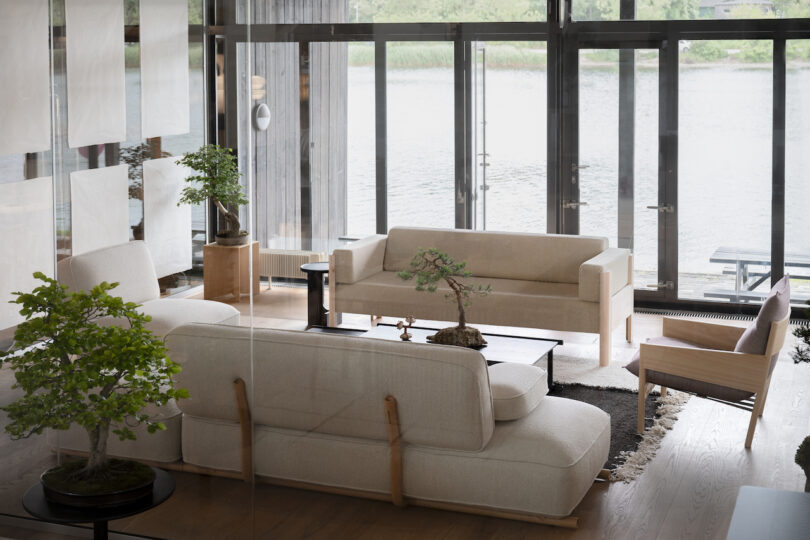In the art of furniture design, mastery involves developing a deep and intimate knowledge of the materials used to turn sketches into prototypes before fully realizing final products. That’s exactly what Japanese furniture brand Ariake facilitated in October 2023 when it led a cohort of notable designers and brands – including Gabriel Tan, Anderssen&Voll, Keiji Ashizawa, Norm Architects, Monica Förster, Naoki Terada, and Christian Haas – through a week-long design workshop in Saga, Japan.
There, the designers met with Ariake’s Hinoki partner factory, which grows, harvests, and processes the prized Japanese Cypress wood. The group was also introduced to Gen Taniguchi, the owner and master craftsman of Nao Washi, a three-hundred-year-old family-run washi mill that transforms Kaji trees into washi paper. This immersive experience provided the designers with new tools and insights to create Ariake’s new 8-piece, 2024 collection Nagare.
Nagare, which means flow in Japanese, symbolizes the ways events unfurled leading to the collection while referencing water in a nod to the DesignHouse CPH in Copenhagen where Ariake launched the collection, co-presented with its European distributor Est.18, at the 2024 3daysofdesign fair. Featuring eight new products, the collection highlights the materiality of Hinoki and Washi wood.
Gabriel Tan, inspired by the Japanese carp, designed the solid wood Koi chair with soft curves like the fish. With its generous backrest and organic armrests, the chair can be placed in both dining rooms and home offices, a conscious decision noting the hybrid nature of modern live-work spaces.
Tan also created a set of nesting tables that can adapt to the confines of any space. Futago, meaning “twins” in Japanese, consists of a primary table and a smaller, secondary surface that effortlessly glides in and out. This allows the user to create a longer coffee table if needed or remove the smaller component completely, using it as a side table that can be put away when not in use.
Christian Haas reimagined the iconic sling typology with the Sedai chair. Ideal for lounging, the seat features a Japanese saddle leather that will patina with age and a modern, solid wood structure that differentiates it from others in its category.
Translating to sunrise, the Hinode dressing table by Monica Förster alludes to its name with the round mirror that seems to emerge over the tabletop’s horizon. The composition has an air of lightness to it, thanks to its delicate but structurally sound proportions.
Keiji Ashizawa leaned into his new learnings from both the Hinoki factory and Washi mill to create the Nao cabinet, in collaboration with Nao Washi. Reminiscent of the traditional Japanese shoji screen used to separate different rooms within the home, the cabinet is quietly elevated with details like recessed handles and edge hinges.
Inspired by its own Braid Collection, Norm Architects expanded the series with its Braid Chair. The paper cord woven armrests now fill a curved rendition of the chair, a subtle departure from the rectilinear forms of the original collection. Available in two different heights, it fits in both dining and lounge spaces.
Tondo, which means framing or cutting marks within the context of Japanese printing, is the name of Naoki Terada’s minimalist sofa. Solid Hinoki wood frames the seating and its geometric cushions, all the while giving a throw of that intoxicating citrusy Hinoki scent.
Anderssen&Voll’s Zabu chair is an abbreviated name for Zabuton, the traditional Japanese floor cushion that the team was inspired by. The belts that support the cushions on the front and back bars of the seat, which are normally hidden from sight, are instead proudly displayed to visually express the structure’s rhythm.
Last but not least, the Hoyo collection by Francesco Rota originally launched in 2022 gets a “kaizen,” or “good change.” The updated series of sofas and chairs introduces wooden runners at the bottom of the cushions that allow the possibility to connect multiple modules together. Hoyo, which means embrace, softly cradles the user with its plush seat cushion and backrest.
To learn more about the entire Nagare collection, visit ariakecollection.com.
Bonsai by Bonsai Murin and Washi Pebble Sculptures by Gen Taniguchi were also on view at the exhibition.
Photography by Sebastian Stadler.
